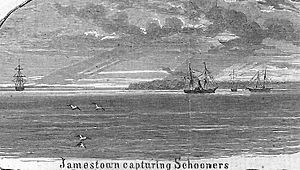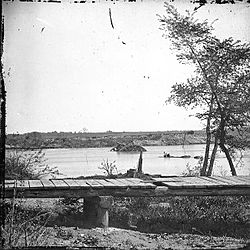CSS Jamestown facts for kids
class="infobox " style="float: right; clear: right; width: 315px; border-spacing: 2px; text-align: left; font-size: 90%;"
| colspan="2" style="text-align: center; font-size: 90%; line-height: 1.5em;" | 
|} The CSS Jamestown' was a steamboat built in New York City in 1853. It was first a passenger ship. In 1861, at the start of the American Civil War, the ship was taken by the Virginia State Navy in Richmond, Virginia. Later, in July, it joined the Confederate States Navy (CSN). It was officially renamed CSS Thomas Jefferson. But most people still called it Jamestown, after the town of Jamestown, Virginia.
The Jamestown was designed by a famous shipbuilder named William Henry Webb. It was built for the New York and Old Dominion Line. It was a sister ship to the Yorktown, which later became the CSS Patrick Henry.
Contents
| History | |
|---|---|
| Name | Jamestown |
| Namesake | Jamestown, Virginia |
| Launched | 1853 |
| Commissioned | July 1861 |
| Decommissioned | May 15, 1862 |
| Fate | Sunk to obstruct James River |
| General characteristics | |
| Displacement | 1300 tons |
| Length | 250 ft (76 m) |
| Beam | 34 ft (10 m) |
| Draft | 17 ft (5.2 m) |
| Propulsion | Steam engine |
| Armament | 2 guns |
The Jamestown's Story
The CSS Jamestown was very active from July 1861 until May 1862. Lt. Joseph Nicholson Barney was in charge of the ship.
Battle of Hampton Roads
One of its most important moments was the Battle of Hampton Roads on March 8–9, 1862. During this battle, the Jamestown helped the CSS Virginia attack two Union ships: the USS Congress and the USS Cumberland. The Jamestown also stayed nearby during the famous fight between the USS Monitor and the Virginia. The Confederate Congress later thanked the officers and crew of the Jamestown for their brave actions in this battle.
Capturing Ships
About a month later, on April 11, 1862, the Jamestown and the Virginia sailed from Norfolk, Virginia. They went into Hampton Roads with five other Confederate ships. They were in full view of the Union ships there. When the Union ships did not attack, the Jamestown moved in. It was protected by the Virginia and the other ships. The Jamestown captured three merchant ships. With help from the CSS Raleigh, it towed them to Norfolk. The captured ships were the brigs Marcus of Stockton, NJ and Sabout of Providence, RI. The third was the schooner Catherine T. Dix of Accomac County, VA. Their flags were flown upside down to tease the Union forces into fighting.
Moving Supplies and Troops
Later that month, the Jamestown was sent to the James River. It was there to help Major General John B. Magruder of the Confederate Army. In early May, the ship was used to carry sick and wounded soldiers to Richmond, Virginia. On the night of May 5, the Jamestown and Patrick Henry went to Norfolk. They returned the next night with the CSS Richmond, CSS Hampton, and boats carrying military supplies. They passed the Union battery at Newport News, Virginia without being seen both times.
Final Days
On May 8, the Jamestown was told to tell Stephen Mallory, who was the Secretary of the Confederate States Navy, about a fight. Two Union gunboats and the ironclad USS Galena were fighting Confederate forts at Day's Point. The Jamestown could not complete its mission. It went up the James River to Drewry's Bluff. On May 15, 1862, the Jamestown was sunk on purpose. This was done to block the river channel and stop Union ships from passing.
Commanders
The commanders of the CSS Jamestown were:
- Lt. Joseph Nicholson Barney (1861–1862)
- Lt. George W. Harrison (May 1862, temporarily)


